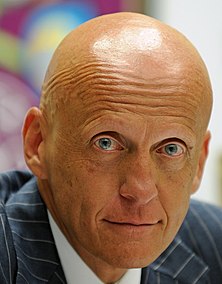Alopecia universalis
| Alopecia universalis | |
|---|---|
 | |
| Formerassociation footballrefereePierluigi Collinawith alopecia universalis. | |
| Specialty | Dermatology |
Alopecia universalis(AU),also known asalopecia areata universalis,is amedical conditioninvolving the loss of all body hair, includingeyebrows,eyelashes,chest hair,armpit hair,andpubic hair.It is the most severe form ofalopecia areata(AA).[1]People with the condition are usually healthy and have no other symptoms and a normal life expectancy.[2]
Causes[edit]
Alopecia universalis can occur at any age, and is currently believed to be anautoimmune disorder,in which a person's immune system attacks the hair follicles. Genetic factors may contribute to AU, as about 20% of those affected have a family member with alopecia.[3]
Treatment[edit]
Many treatments have been explored, includingimmunomodulatoryagents such asimiquimod.[4]Tofacitinib citratemay also have benefits. In June 2014, a 25-year-old man with almost no hair on his body was reported to have grown a full head of hair, as well as eyebrows, eyelashes, and facial, armpit, and other hair, following eight months of treatment.[5]
Contact immunotherapy involves the use of contact allergens, such asdiphencyproneandsquaric acid dibutylester,to induce an immune response that is thought to oppose the action of cells causing hair loss.[6][7][8]A review that combined and analyzed the findings of 45 studies comprising 2,227 patients showed any hair regrowth in 54.5% and complete hair regrowth in 24.9% of patients with AT and AU using contact immunotherapy.[9]In addition to its helpful effects in treating AU, it can have side effects that can be very serious, such as severedermatitis.[6][10]
Topical and intralesionalcorticosteroids,such asclobetasol propionate,have also shown to be an effective treatment for AT and AU patients.[6][7]A controlled study comprising 28 patients found positive terminal hair growth in eight of the patients (28.5%) using a 0.05% clobetasol propionate ointment.[11]This is very similar to the results obtained from immunotherapy treatment trials. Additionally, studies suggest that intralesional applications are much more effective than topical applications of steroids. However, the main side effect is increased risk ofcutaneous atrophyat the site of treatment;[7]folliculitisis also an occasional complication.[8]
Janus kinase inhibitors,previously used in the treatment of cancer and other diseases, such asarthritis,have successfully shown to be effective in the initial trials of treatment for alopecia patients.[6][7][12]Multiple cases of treatments have been successful, one of them being of a 22-year-old man with a history of AU andatopic dermatitis(AD). This man was treated with JAK inhibitortofacitinib,and after ten months, he experienced hair regrowth on all of his affected body parts and subsequent improvement of his AD.[13][14]Current research and findings suggest that systemic JAK inhibitors eliminate and prevent the development of AA, while topical JAK inhibitors promote hair regrowth and reverse the established disease.[8][15]Many clinical trials are ongoing involving JAK inhibitors such asruxolitiniband tofacitinib.[6][16]
See also[edit]
References[edit]
- ^"Alopecia universalis | Disease | Overview | Genetic and Rare Diseases Information Center (GARD) – an NCATS Program".rarediseases.info.nih.gov.Archived fromthe originalon 2016-03-07.Retrieved2016-03-01.
- ^Nancy Garrick, Deputy Director (4 April 2017)."Alopecia Areata".National Institute of Arthritis and Musculoskeletal and Skin Diseases.Retrieved27 November2021.
- ^Robins, Douglas N. (September 2007)."Alopecia Universalis: Hair Growth following Initiation of Simvastatin and Ezetimibe Therapy".Journal of Drugs in Dermatology.6(9): 946–7.PMID17941369.Retrieved31 August2020.
- ^Letada PR, Sparling JD, Norwood C (2007). "Imiquimod in the treatment of alopecia universalis".Cutis; Cutaneous Medicine for the Practitioner.79(2): 138–40.PMID17388216.
- ^"Hairless Man Grows Full Head Of Hair In Yale Arthritis Drug Trial".CBS Boston. 2014-06-19.Retrieved2022-04-07.
- ^abcdeKhan Mohammad Beigi, Pooya (2018), Khan Mohammad Beigi, Pooya (ed.), "Alopecia Totalis/Universalis",Alopecia Areata: A Clinician's Guide,Springer International Publishing, pp. 13–15,doi:10.1007/978-3-319-72134-7_3,ISBN9783319721347
- ^abcdDarwin, Evan; Hirt, PenelopeA; Fertig, Raymond; Doliner, Brett; Delcanto, Gina; Jimenez, JoaquinJ (2018)."Alopecia areata: Review of epidemiology, clinical features, pathogenesis, and new treatment options".International Journal of Trichology.10(2): 51–60.doi:10.4103/ijt.ijt_99_17.ISSN0974-7753.PMC5939003.PMID29769777.
- ^abcPratt, C. Herbert; King, Lloyd E.; Messenger, Andrew G.; Christiano, Angela M.; Sundberg, John P. (2017-03-16)."Alopecia areata".Nature Reviews Disease Primers.3:17011.doi:10.1038/nrdp.2017.11.ISSN2056-676X.PMC5573125.PMID28300084.
- ^Lee, Won-Soo; Lee, Young Bin; Kim, Beom Jun; Lee, Solam (2018-10-01)."Hair Regrowth Outcomes of Contact Immunotherapy for Patients With Alopecia Areata: A Systematic Review and Meta-analysis".JAMA Dermatology.154(10): 1145–1151.doi:10.1001/jamadermatol.2018.2312.ISSN2168-6068.PMC6233743.PMID30073292.
- ^Strazzulla, Lauren C.; Wang, Eddy Hsi Chun; Avila, Lorena; Lo Sicco, Kristen; Brinster, Nooshin; Christiano, Angela M.; Shapiro, Jerry (January 2018). "Alopecia areata: An appraisal of new treatment approaches and overview of current therapies".Journal of the American Academy of Dermatology.78(1): 15–24.doi:10.1016/j.jaad.2017.04.1142.ISSN1097-6787.PMID29241773.
- ^Tosti, Antonella; Piraccini, Bianca Maria; Pazzaglia, Massimiliano; Vincenzi, Colombina (July 2003). "Clobetasol propionate 0.05% under occlusion in the treatment of alopecia totalis/universalis".Journal of the American Academy of Dermatology.49(1): 96–98.doi:10.1067/mjd.2003.423.ISSN0190-9622.PMID12833016.
- ^Clynes, Raphael; Christiano, Angela M.; Vaughan, Roger; Furniss, Megan; Ulerio, Grace; Clark, Charlotte; Cerise, Jane E.; Nguyen, Nhan; Jabbari, Ali (2016-09-22)."Oral ruxolitinib induces hair regrowth in patients with moderate-to-severe alopecia areata".JCI Insight.1(15): e89790.doi:10.1172/jci.insight.89790.ISSN0021-9738.PMC5033756.PMID27699253.
- ^Morris, Gabriela M.; Nahmias, Zachary P.; Kim, Brian S. (2018-07-01)."Simultaneous improvement of alopecia universalis and atopic dermatitis in a patient treated with a JAK inhibitor".JAAD Case Reports.4(6): 515–517.doi:10.1016/j.jdcr.2017.12.016.ISSN2352-5126.PMC6047104.PMID30023415.
- ^Navarini, Alexander A.; French, Lars E.; Trüeb, Ralph M.; Kamarachev, Jivko; Maul, Julia-Tatjana; Anzengruber, Florian (2016)."Transient Efficacy of Tofacitinib in Alopecia Areata Universalis".Case Reports in Dermatology.8(1): 102–106.doi:10.1159/000445182.ISSN1662-6567.PMC4869306.PMID27194979.
- ^Clynes, Raphael; Christiano, Angela M.; Mackay-Wiggan, Julian; Petukhova, Lynn; Singh, Pallavi; Rothman, Lisa; DeStefano, Gina M.; Harel, Sivan; Jong, Annemieke de (September 2014)."Alopecia areata is driven by cytotoxic T lymphocytes and is reversed by JAK inhibition".Nature Medicine.20(9): 1043–1049.doi:10.1038/nm.3645.ISSN1546-170X.PMC4362521.PMID25129481.
- ^Craiglow, Brittany G.; King, Brett A. (December 2014)."Killing Two Birds with One Stone: Oral Tofacitinib Reverses Alopecia Universalis in a Patient with Plaque Psoriasis".Journal of Investigative Dermatology.134(12): 2988–2990.doi:10.1038/jid.2014.260.ISSN0022-202X.PMID24940651.
